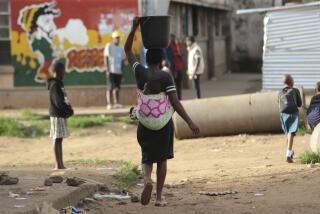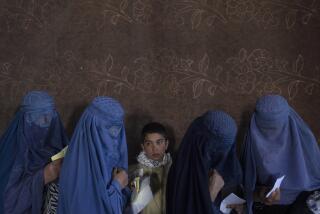Women’s Status: Sweden Put 1st, Bangladesh Last
- Share via
WASHINGTON — They still lack full equality with men, but women in the United States and Northern Europe enjoy more freedom, better health and longer lives than their counterparts elsewhere, while women in much of the underdeveloped world continue “poor, powerless and pregnant,” with little chance for improvement.
These are findings of a study made public Sunday by the Population Crisis Committee, a Washington-based research group that works to slow world population growth. Its 6,000-word study was derived from data in five areas--health, marriage and children, education, employment and social equality. The findings were the basis for charts ranking the relative status of 2.3 billion women in 99 nations--92% of the world’s female population.
Health Threatened
“Over 60% of all women and girls in the world live under conditions that threaten their health, deny them choice about childbearing, limit educational attainment, restrict economic participation and fail to guarantee them equal rights and freedoms with men,” said the study, which the committee is distributing to 75,000 opinion leaders worldwide.
Sharon Camp, vice president of the committee and the report’s author, conceded in an interview that the study would meet with a poor response from “countries who believe that we are imposing a Western feminist standard on the data which is irrelevant to their traditional cultural values.”
“And they’re perfectly right,” she continued, “if they mean that we take the position that women should have equal access to education; that there should be as many literate women as men; that constitutional and other legal protections should ensure equal political participation by women and equal access to credit and employment.”
Camp foresaw continued improvement in the status of women in highly industrialized countries and in such emerging industrial nations as Brazil, Mexico, Taiwan and South Korea. But she said she fears that lack of resources in the poorer nations of South Asia and Africa will prevent sufficient economic expansion to provide new opportunities there for women.
“I am optimistic,” she said, “about the third of the world that is growing economically . . . but very pessimistic about what will be the lot of women in the world’s poorest countries.”
The report gave no nation a perfect score. It ranked the status of women in Sweden first with an 87% score and placed impoverished Bangladesh last with 21.5%.
Contrasting the situation of women in Sweden and Bangladesh, the report found that:
--Life expectancy for Swedish women is 81, seven years longer than that of men. Although women live longer worldwide, the average Bangladeshi woman lives to be 49, two years less than the average man in a culture where, from birth, males get better food and care than females.
--In Sweden, one girl in 167 dies before age 5, while in Bangladesh, one girl in five fails to see her fifth birthday.
--One Swedish 15-year-old out of 53 will not survive her childbearing years, while in Bangladesh, the ratio is one in six. About a third of the Bangladeshi deaths relate to pregnancy and childbirth, which figure in only 1% of the Swedish deaths.
--While the average Swedish woman bears one to two children, the average in Bangladesh is five to six. Contraception is practiced by three-fourths of Swedish women, but only a quarter of Bangladeshi women.
--In Sweden, virtually all school-age girls are in school and 37% of women aged 20 to 24 are enrolled in universities; in Bangladesh, two-thirds of school-age girls are not in school and female university enrollment is less than 2% of the 20-to-24 group.
--Literacy is almost universal for both sexes in Sweden, but the illiteracy rate for Bangladeshi women is 24% higher for than for men. The gap is even higher in Syria, Tanzania and Turkey, but it is largest in Libya, where there are 50% more literate men than women.
--In Sweden, 60% of women work and make up about half the paid work force, while only 7% of Bangladeshi women work for pay, comprising 14% of the labor force.
Contributions Underestimated
The report found that official statistics tend to underestimate the economic contribution of women, particularly in poor rural countries where subsistence farming is widespread. It cited surveys indicating that women working without pay do three-fourths of the farm work in Africa and half of such work in Asia.
Whereas women make up 40% or more of the work force in the United States, Canada, Northern Europe and much of Eastern Europe, the report said, less than 8% of the paid labor pool in most Arab countries is female.
In all the nations surveyed, the study found substantially more women than men who were widowed, divorced or separated. In China, it reported 182 women in these categories for every 100 men, while in Bangladesh the ratio was 927 to 100.
The study suggested that the proportion of households headed by women had been substantially understated in some countries, especially nations where there is a migration of males looking for work. It estimated that women head 20% of households in Peru, Honduras, Venezuela and Cuba and about 40% of households in parts of rural Kenya, Botswana and Ghana.
But as a reminder that “feminization of poverty is not confined to the world’s poor countries,” the report noted that a sixth (16%) of U.S. households are now headed by non-married women--mostly divorcees and teen-age mothers--who receive the bulk of welfare payments.
‘Double Day’ of Work
Another pattern that emerges from the study is that virtually all the women have the “double day,” Camp said.
“Whether it’s a Bangladeshi woman going out every day carrying dirt in a basket on her head for irrigation work for 40 cents a day, or the U.S. female physician trying to balance responsibilities toward young children and a full-blown career, they are both working a double day,” Camp said.
In the report’s overall performance ranking, the runners-up to Sweden’s 87% were Finland, rated at 85%--and edging out the United States, with 82.5%, Norway with 81.5%, Canada with 80.5% and Denmark with 80%. All North European nations rated over 70% except Ireland, which was listed at 66%.
Saudis Score Low
One of the lowest ratings went to one of the world’s wealthiest nations, oil-rich Saudi Arabia, which was scored at 29.5%, not much above the 26.5% rating given underdeveloped Yemen, its Muslim neighbor on the Persian Gulf. Saudi Arabia scored well on health, but got bottom ratings in the other categories.
Without direct reference to male-oriented Islamic traditions prevailing in the nations of the gulf, the report noted that “laws based on religious and cultural norms actually reinforce women’s subordinate status in many aspects of life.”
The report, entitled “Country Rankings of the Status of Women: Poor, Powerless and Pregnant,” is the committee’s third major study in a continuing series that analyzes problems related to population, family planning and development. Camp said most of the raw data scaled in the study had been taken since 1980.
More to Read
Sign up for Essential California
The most important California stories and recommendations in your inbox every morning.
You may occasionally receive promotional content from the Los Angeles Times.













